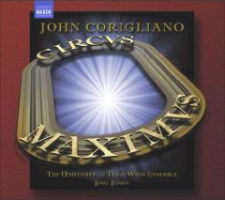
Glamorous Barbarity
John Corigliano's
'Circus Maximus' -
heard by
RON BIERMAN'The performances could not be bettered ...'
|

|
Bring on the gladiators! John Corigliano is ready, and so is the University of Texas Wind Ensemble. Corigliano here satirizes the human need for 'glamorous barbarity', whether it be lions devouring Christians at the Circus Maximus or minor celebrities covering themselves in tarantulas on a TV reality show.
The spectacle begins with trumpet passages suitable for the next remake of Ben Hur.
Listen -- Corigliano: Introitus (Symphony No 3, Circus Maximus)
(track 1, 0:01-0:57) © 2009 Naxos Rights International Ltd
The chaotic third movement makes it clear that decadent Romans aren't the only target. Sudden contrasts jar as the music surfs from one cable station to another.
Listen -- Corigliano: Channel Surfing (Symphony No 3, Circus Maximus)
(track 3, 0:00-1:24) © 2009 Naxos Rights International Ltd
The work isn't all violence. II suggests the seductive allure of a film siren. IV, titled Night Music I, evokes the mysterious quiet of a forest filled with eerie natural sounds. But then the barbarous returns in Night Music II. Without a break, soft forest segues to the tumultuous and confusing chaos of a metropolis.
VI, Circus Maximus, is the centerpiece. The brass instruments become wailing sirens and screeching alarms. Thematic fragments recall the first movement. Quiet returns one more time with Prayer before the eighth and concluding movement again recalls the brassy opening.
Listen -- Corigliano: Prayer (Symphony No 3, Circus Maximus)
(track 7, 5:14-5:58) © 2009 Naxos Rights International Ltd
Listen -- Corigliano: Coda:Veritas (Symphony No 3, Circus Maximus)
(track 8, 1:06-1:30) © 2009 Naxos Rights International Ltd
That final exclamation point is provided by a shotgun. 12-gauge is specified, preferably with a black-powder full-load because 'it is louder and throws a much larger flame from the barrel.'
It's not saying much to point out that the other piece on the program is lighter fare. Gazebo Dances for Band begins with a slightly tipsy but high-spirited overture.
Listen -- Corigliano: Overture (Gazebo Dances for band)
(track 9, 3:39-4:45) © 2009 Naxos Rights International Ltd
The following waltz movement claims further inebriation before a gentle adagio pauses for reflection, and then celebration returns as the work rushes home with a sparkling Scottish-flavored tarantella.
These pieces are over-the-top extroverts, and Naxos has the ideal interpreters. The University of Texas Wind Ensemble led by Jerry Junkin plays with entirely appropriate youthful exuberance in the wilder moments and with a perfectly idiomatic jazz-feel when needed for brash sliding trombones or slinky saxophones. The performances could not be bettered by a professional organization.
The CD jewel box comes in a sleeve with a bold three-dimensional image on the front cover which is a nod to the three-dimensional deployment Corigliano calls for in concert performances of the symphony. The composer includes stage directions in his score. Some players are on the stage, but others march in the aisle or are placed elsewhere in the audience. A performance must be quite an event, and my only complaint about the recording is that Naxos hasn't produced a surround-sound version.
The churlish will point out that Corigliano's Circus Maximus suffers from the same pandering excesses it satirizes. So be it. This inheritor of Roman crassness loved it.
Copyright © 23 June 2009
Ron Bierman,
San Diego, USA
 CD INFORMATION: JOHN CORIGLIANO: CIRCUS MAXIMUS
CD INFORMATION: JOHN CORIGLIANO: CIRCUS MAXIMUS
JOHN CORIGLIANO ROMANS CHRISTIANS NAXOS UNITED STATES OF AMERICA
| 
